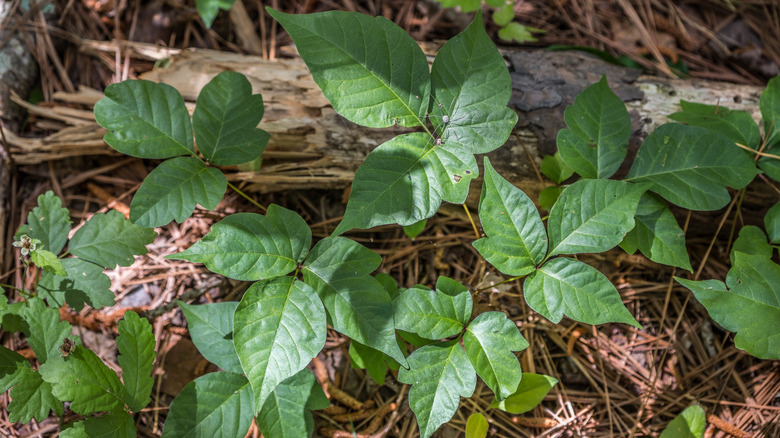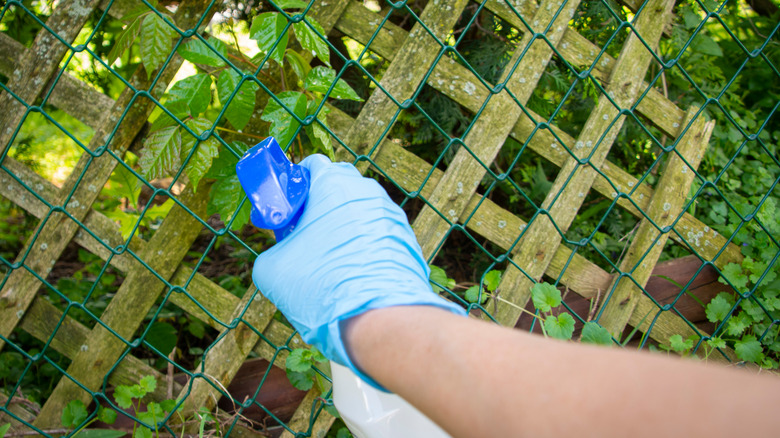8 Best Ways To Kill And Get Rid Of Poison Ivy
We've all been there at some point or another: scratchy, swollen, and covered in hives after an afternoon in the backyard, lathering up the calamine lotion like it'll do the trick (newsflash: it won't). The only thing worse than getting a rash from poison ivy is the never-ending fear of every weed that pops up in your yard afterwards. Always make note of the number of leaves on an ivy plant or weed before you go making any sudden movements mid-gardening, per the National Park Service. Repeat after us: "leaves of three, let it be."
But as much as we'd all like to avoid another brush with the poisonous plant, sometimes, you simply can't "let it be." Poison ivy could be overtaking a patch of grass that your kids frequent, or maybe it's popping up in the cracks of your driveway, threatening an inevitable ankle rash each time you have to carry the groceries in — there's just no ignoring it. If you want to actually rid your yard of the stubborn plant, consider taking one of these approaches to kill poison ivy once and for all.
1. Weeding
This one's scary — we'll admit it. But with great risk comes great reward! With a plant as persistent as poison ivy, the best option is to tackle the problem from the root. Gardening Know How explains that poison ivy will easily grow back time and time again unless the entire plant is uprooted from the ground. That means it's time to suit up — grab tighter, full-coverage clothes, a pair of thick gloves, and cross your fingers.
Wait until right after a heavy rain, when the soil is drenched and the roots are loose enough to come out with a gentle tug. Unfortunately, since the plant is so stubborn, there may be some regrowth over time — all you have to do is get out and get weeding once again, and it should eventually stop coming back.
After weeding the poison ivy, you should rinse off immediately in case your skin made contact with the plant. Wash your clothes and gloves separately to avoid transferring the poisonous oils. If all goes according to plan, you'll stay rash and poison ivy free!
2. Boiling water
If you don't quite want to risk touching live poison ivy, you'll still want to get suited up for this easy option. All you have to do is boil some water and pour it directly over the plant — just be sure not to burn yourself, or come into contact with the ivy. Just like with weeding, the plant may return a few times before slowing down its growth, then eventually it will disappear completely. That's sadly a standard pattern for poison ivy, since it's such an invasive plant.
The only con to this option, says Gardenista, is that boiling water is an aggressive solution. It's easy and it's effortless, but be warned: Boiling water will kill any and all vegetation around the poison ivy as well. So if the plant is growing alongside your prettiest perennials, stick with a more concentrated method to avoid any accidental garden casualties.
3. Salt and dish soap
Another effective natural solution to stopping poison ivy in its tracks is already right in your kitchen. Grab an empty, clean spray bottle, some dish soap, water, and plenty of salt — you're going to need it.
Mix together a solution of 1 gallon of water, 1/4 cup of dish soap, and 3 entire pounds of salt. You can transfer some to a spray bottle to have better control when applying it on the plant. Spray the mixture directly on the leaves and let the salt sit — it'll slowly eat away at the poison ivy until you reapply again.
According to Bob Vila, this DIY weed killer is an environmentally friendly option, and it's one that many landscapers swear by. Try giving this a go before you turn to harsher chemicals — while it may also damage and kill any neighboring plants, it could help save your grass and garden in the long run!
4. Cover it up
If you're looking for the solution with the absolute least amount of work possible — which, we can't blame you, because who wants to be out messing around with poison ivy on the regular? — you may be able to get rid of the plant once and for all by covering it up.
And we're not talking just the good old "out of sight, out of mind" approach, either. You can actually physically cover up poison ivy with cardboard, a tarp, mulch, plastic, wood chips, you name it — just toss whatever will fully block the sun from coming into contact with the area. This will effectively kill whatever is underneath the covering, since it's not able to grow and survive without the sunlight. Just be mindful of any "runners," says HGTV. Since poison ivy is notorious for regrowth at the root, you may encounter some small patches popping up again on the outskirts of the shaded area.
5. White vinegar
This method is not much of a shock since white vinegar just does it all. If you don't have a steady stock of distilled vinegar in your cleaning cabinet by now, then it's about time you buy in bulk, especially since it now has a use in the backyard, too.
SF Gate says that the natural cleaner actually works to kill any kind of ivy types since it's highly acidic. All you have to do is fill a spray bottle and completely douse the ivy — roots, leaves, and all — until it's soaked in the vinegar. Be careful not to spray it on any surrounding grass or plants, since it'll likely kill those as well.
After one week, the leaves should look dried out and brown. Spots of green are a sign of a live poison ivy plant, so if that's the case, give it another generous spray and check back again after another few days. Once the plant is fully dead, wear gloves to weed and (finally!) dispose of the ivy.
6. Bleach, salt, and hydrogen peroxide
Say you tried to get rid of the poison ivy before you realized it was poison ivy, and now you're itchy and stuck with this stubborn plant on top of that — what now? This hack from Hunker may just be the easy 2-in-1 DIY solution you didn't know you needed. Combine 1/2 of a bottle's worth of warm water with a 1/2 cup of salt, 1/2 a cup of hydrogen peroxide, and 2 cups of bleach. Unlike the other salt solution we mentioned, you're going to want to wait for the salt to dissolve before getting to work. Then, carefully soak the entire ivy plant and its leaves. It should be gone in a few days, but continue to spray with the solution as needed.
The best part? After you're done spraying, you can dip a cotton ball in the mixture and dab it over the poison ivy rash on your skin. Hunker says that this combo is perfectly safe for the skin and will slow any irritation, but always test on a small area beforehand.
7. Herbicide sprays
Unfortunately, with an invasive species like poison ivy, the chance for regrowth is always there. If you have a particularly pesky ivy plant that just won't quit — even after you've tried all the natural removers and risked night after night of endless itching — then you may want to consider a herbicide spray or chemical remover. One option is Roundup, which is a popular herbicide spray designed to aggressively kill poison ivy within a few weeks after its first use.
Using any chemicals to eliminate poison ivy is a controversial topic among landscapers and gardeners because of the effects it could have on the surrounding soil, plants, and general environment. Tenth Acre Farm suggests spraying any herbicides on the stillest, calmest day possible, to avoid any wind carrying the harmful chemicals to unwanted areas. The farm even says that while they wouldn't typically suggest the use of herbicides, poison ivy is the one exception, since it minimizes the need to return and take care of any regrowth. Sometimes, you've exhausted all other options, and need the invasive plant gone for good — that's where herbicide sprays come in.
8. Goats
Yes, goats. In contrast to chemical weed killers, this may seem laughable — but trust us, it's a thing! If you happen to know of any goats that can swing by your property (or you're fortunate enough to have some of your own), these adorable animals can actually eradicate any existing poison ivy.
Goats naturally possess enzymes that make it perfectly safe to digest poisonous plants, and they also happen to be very hungry animals. They actually love grazing on poison ivy plants, according to Eco-Goats President Brian Knox, who spoke about the bizarre method with Maryland-based paper The Frederick News Post.
If you live in Maryland, Virginia, or Delaware and can't seem to tackle the poison ivy overtaking your property, then you can even hire Eco-Goats directly — they'll schedule a time for the goats to come graze and eat away at the problem! That means cute farm animals, no more rashes, zero effort, and it's environmentally safe — now that's the way to kill poison ivy.








